Day 1 :
Keynote Forum
Donna Lybecker
Idaho State University, USA
Keynote: Sustainable communities: Communicating with the public on science-based social issues and policies
Time : 09:30-10:15

Biography:
Donna L Lybecker is a Professor of Political Science and Chair of the Political Science Department at Idaho State University in Pocatello, Idaho, USA. Her research and teaching cover the areas of Environmental Politics and International Relations, with emphasis on water policy, political narrative, and border studies. Current research includes work on ecosystem services, focusing on the political and ecological linkages between the environment and people, including health related elements; public and stakeholders’ values, perceptions, and uses of resources; and the effects of policy narrative on perception and policy development surrounding international borders. With her research, Dr. Lybecker aims to improve decision-maker and public understanding of human-environmental connections and contribute to better-informed conservation. Recent publications include articles in Environmental Politics, International Journal of Sustainable Society and Politics and Policy.
Abstract:
Policy analysts in the United States, and many democracies, are taught they are not advocates for, but rather trustees of the public interest. However, policy analysts often lack political communication skills in how they present science-based information such as environment and health issues, finding their data ignored or manipulated by others. Using environmental issues in the United States, this paper suggests understanding both the values behind policy prescriptions and the values of constituents can help policy analysts educate the public without engaging in manipulating the public.

statistical evidences
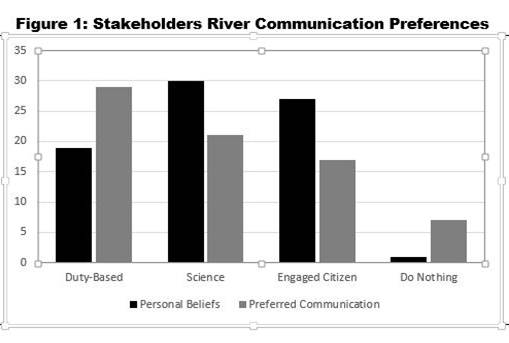
Stakeholders’ Communication choices
References:
Lybecker D, McBeth M, Brewer A, De Sy C. (2017: Forthcoming) The Social Construction of a Border: The US-Canada Border. Journal of Borderlands Studies.
McBeth M, Lybecker, D, Stoutenborough, J, Running K, Davis S (2017: In Press) Content Matters: Stakeholder Assessment of River Stories or River Science. Public Policy and Administration. (DOI: 10.1177/0952076716671034)
Lybecker D, McBeth M, Stoutenborough J (2016) Do We Understand What the Public Hears? Stakeholders’ Preferred Communication Choices for Discussing River Issues with the Public. Review of Policy Research 33, 4: 376-392.
Lybecker D, McBeth M, Husmann M, Pelikan N. (2015) Do New Media Support New Policy Narratives? The Social Construction of the US-Mexico Border on YouTube. Policy and Internet 7, 4: 497-525.
Lybecker D, McBeth M, Kusko E. (2013) Trash or treasure: recycling narratives and reducing political polarization. Environmental Politics 22, 2: 312-332.
Keynote Forum
Catherine Hakim
London School of Economics, UK
Keynote: The male sexual deficit: A social fact of the 21st century – and its many consequences
Time : 10:15-11:00

Biography:
Catherine Hakim is a pioneering social scientist, Professorial Research Fellow with Civitas, a London think tank, and a regular commentator in the media. She has worked in the Centre for Policy Studies, London, and the WZB research institute in Berlin. Her professional experience spans central government, consultancy, and academia. In the British Ministry of Employment, she initiated research on occupational segregation, the pay gap, and home-based work. As a Senior Research Fellow and Professor in the London School of Economics she developed Preference Theory, and a theory of the social and economic value of Erotic Capital. She is an internationally recognized expert on women's employment, social and family policy, voluntary childlessness and the male sexual deficit. Her publications include over 100 papers published in social science journals and edited collections, several textbooks, including Key Issues in Women’s Work and Research Design, books and research monographs. See www.catherinehakim.org
Abstract:
Nationally representative interview surveys of sexual behavior and attitudes proliferated around the globe from 1990 onwards as a result of the AIDS scare, yet are overlooked by sociologists and economists. We review findings from some 30 national sex surveys around the world showing that large and substantively important differences between men and women in the centrality of sexuality, sexual desire, sexual behavior and sexual attitudes persist in the 21st century, long after the contraceptive and sexual revolutions of the 1960s gave women access to recreational sex on the same level as men have enjoyed historically. Women’s lesser sexual motivation and interest means that many heterosexual men experience a shortfall in desired sexual activity, both within and outside long-term relationships. A reversal of the sex ratio to a male surplus among prime age adults, women’s access to economic independence, and other trends suggest that the sexual deficit among men is increasing long term. The male sexual deficit (or surplus male sexuality) helps to explain sexual harassment, sexual violence, rape, rising demand for commercial sexual services and other behaviors that are almost exclusively male, even in liberal democracies of the Western world.
References:
The New Rules: Economies of Desire, 2nd edition, London: Gibson Square, 2017.
Hakim, C (2015) Supply and Desire: Sexuality and the Sex Industry in the 21st Century, Discussion Paper No. 61, London: Institute of Economic Affairs, August 2015.
Hakim, C. (2012) The New Rules: Internet Dating, Playfairs and Erotic Power, London: Gibson Square.
Hakim, C. (2011) Erotic Capital: The Power of Attraction in the Boardroom and the Bedroom, New York: Basic Books, September 2011.
Kontula, O. (2009) Between Sexual Desire and Reality: The Evolution of Sex in Finlandtrans. M Makinen, Helsinki: Population Research Institute.
Keynote Forum
Ulimiri Somayajulu
Indian Association for Social Sciences and Health, India
Keynote: SDGs and multi sectoral approach
Time : 11:25-12:10

Biography:
Ulimiri V Somayajulu is currently CEO and ED, Sigma Research and Consulting, President, STAR Foundation, President, Indian Association for Study of Population (IASP), and Vice President, Indian Association for Social Sciences and Health. He is a Statistical Demographer and Social Scientist with more than two and half decades of research experience in social and development sector. He is author of nine edited volumes and author of 115 papers published in journals/edited volumes and presented at international and national conferences/seminars. Coordinated more than 500 research studies in social and development sector for UN agencies, international NGOs, academic institutes and Indian Government departments.
Abstract:
In 2000, world leaders adopted the eight Millennium Development Goals (MDGs) which committed nations to a global partnership to reduce extreme poverty by 2015. The implementation of the MDGs led to progress in terms of income poverty, access to improved sources of water, primary school enrollment, and child mortality but poverty remains a reality for many. Lack of integration across sectors was a major gap noticed that had impact on the achievement of the MDGs. Review of global multi-stakeholder partnerships under the MDG agenda reveal that these partnerships reinforced siloed (sectoral) and ‘projectized’ approach to development problems and solutions. The sectoral approach undermined the potential to address the drivers of systemic change and for scaling impact through a more programmatic approach (World Resource Institute, 2015).
In September 2015, world leaders adopted the 2030 agenda for sustainable development along with 17 goals and 169 targets. Integration of economic, social and environmental dimensions of sustainable development and inter linkages existing within and across the goals is the key feature of this agenda. The SDGs build on the key lesson from the MDGs that sustained systemic change cannot be achieved through single-sector goals and approaches. Hence, implementing the 2030 agenda entails breaking down traditional silos for more cross-sectoral decision-making and solutions.
The 2030 sustainable development agenda presents unique opportunity for multi stakeholder partnerships for sustainable development so as to leverage cross-sectoral approaches to enhance effectiveness as well as impact. To avail this opportunity, action is needed to strengthen accountability, transparency, coherence, monitoring, reporting, and knowledge sharing through cross-sectoral multi-stakeholder partnerships.
A review of the SDGs indicates that some thematic areas covered by the SDGs are well connected among one another. Existing link between targets and several SDGs gets demonstrated. The links among sectors that are identified include : education, gender and health nexus, water, energy, food nexus, energy, food security, and poverty eradication nexus, and climate, land, energy, and water nexus.
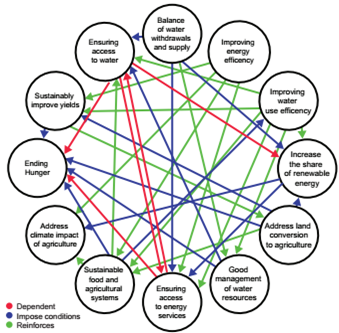
Interactions between proposed water, energy and food targets
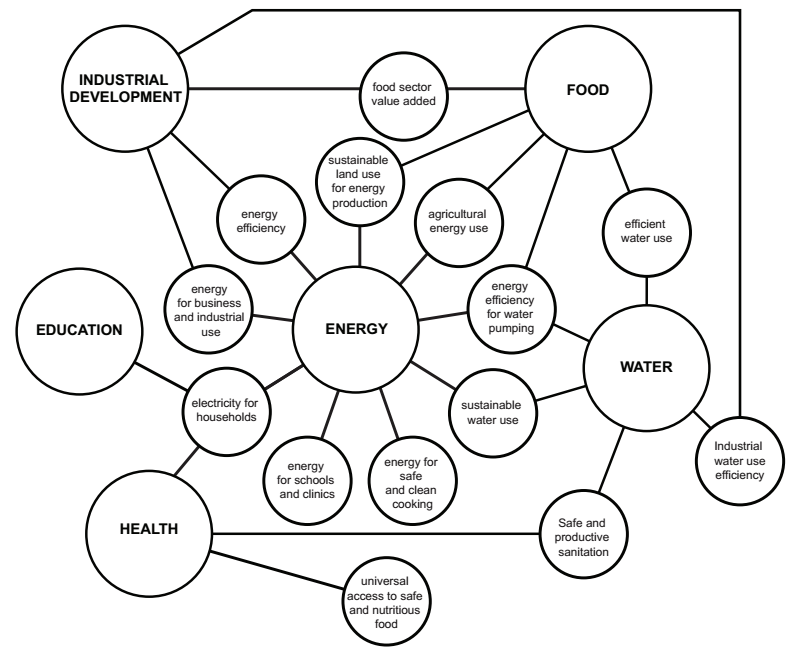
Mapping nexus targets as nodes between goal areas
- Medicine| Behavioral Studies | Epidemiology | Psychology | Education | Natural Sciences | Nursing | Criminology
Location: Atlantis 1

Chair
Donna Lybecker
Idaho State University, USA

Co-Chair
Ulimiri Somayajulu
Indian Association for Social Sciences and Health, India
Session Introduction
Chana Akins
University of Kentucky, USA
Title: Best practices for successful mentoring of today’s graduate students
Time : 12:10-13:10

Biography:
Chana Akins is a professor in the Department of Psychology at the University of Kentucky. Her research interests focus on how drugs of abuse affect behavior and motivation. She has published over 45 peer-reviewed papers and has served on the editorial board for the Psychology of Addictive Behaviors and as Associate Editor for Psychology of Women Quarterly and Learning & Behavior. She has held several leadership positions including Inaugural Class of Leadership Institute for Women in Psychology for the American Psychological Association (APA) and President of APA’s Division 6 (Society for Behavioral Neuroscience and Comparative Psychology).
Abstract:
In the social sciences and other disciplines, student success can be measured by a number of variables: retention, graduation rate, course completion, etc. Among these variables, there are a number of constants. One of these constants has to do with mentoring. Previous research has revealed a strong correlation between faculty mentorship and graduate student success. Effective mentoring advances the discipline because these students often begin making significant contributions long before they complete their graduate degrees. Such students are more likely to have productive and distinguished careers that enrich the discipline. However, mentoring graduate students can be time-consuming and oftentimes very challenging. Effective mentoring requires a commitment to advancing the student’s career and involves developing a professional and interpersonal relationship that facilitates sharing guidance, experience, and expertise. It also requires continuous re-evaluation of student progress and feedback. The fact that today’s students come from increasingly diverse backgrounds, have different ways of communicating, and are increasingly more technological may add complexity but may also be a source of enrichment. The purpose of this workshop is to engage in a dialog about the best practices for successfully mentoring today’s graduate students including serving as a role model, maintaining professional and ethical standards, providing support and guidance, providing training and oversight of research projects, and providing the framework for students to become independent researchers. Ultimately, effective mentoring can be transformative for students who are preparing to be colleagues with their mentors as they move to the next phase of professional life.
Debra Mims
Saint Leo University Campus, USA
Title: Paws on parole programs: Inmates’ perceptions and the impact on the community
Time : 13:50-14:50

Biography:
Mims is a retired Tampa Police Officer. While at the Tampa Police Department Dr. Mims served on the Mounted Patrol Unit, was a Community Police Officer, Bicycle Patrol Officer, and Under-Cover Officer and was an Elderly Abuse Investigator, Domestic Violence Investigator and a Child Abuse Investigator. Dr. Mims holds a doctoral degree in Business Administration with a concentration in Criminal Justice from Northcentral University. She is an undergraduate faculty Professor of Criminal Justice at Saint Leo University and also teaches at the Pasco-Hernando State College and Hillsborough Community College Police Academies. Dr. Mims is a certified firearms instructor, CPR and Basic Life Support instructor and holds a private investigators and recovery agent license. She professionally trains and shows dogs in obedience, agility, freestyle, tricks and therapy and owns five border collies and three papillions.
Abstract:
The purpose of this qualitative study was to explore the perceptions of prison inmates participating in Paws on Parole program. The Paws on Parole program involves incarcerated inmates training local humane shelter canines’ obedience training techniques using the canine good citizen model during an 8 week program. Using secondary data from self-report questionnaires completed by the inmates, this study sought to explore how the inmates felt before and after their exposure to the Paws on Parole program. Specifically, this research seeks to better understand how the Paws on Parole program is perceived as helpful by the inmates in helping them to cope with prison life and their overall personal well-being. Once the dogs have been trained they are distributed into the community in a variety of modalities; from companion dogs, to therapy and service dogs. For years, animals have been used with great benefit in the treatment of the aged and the terminally ill and as service dogs to the infirmed. Animal assisted therapy is thought to be a useful tool for children with mental and physical difficulties; helping to promote a general emotional well-being, aiding in fine motor skills and balance and assisting with both educational and motivational purposes by encouraging long or short-term memory, increasing vocabulary and improving a person’s interaction and involvements with others. Animal therapy is also making strides in the treatment of Post-Traumatic Stress Disorder (PTSD). Animal Assisted Therapy in the treatment of PTSD patients has seen significant results.

Prisons and juvenile detention centers
References:
Aaron, M. (2012). The pathways of problematic sexual behavior: A literature review of factors affecting adult sexual behavior in survivors of childhood sexual abuse. Sexual Addiction & Compulsivity: The Journal of Treatment & Prevention, 19(3), 199–21. doi:10.1080/10720162.2012.690678
Abbe, A., & Brandon, S. (2014). Building and maintaining rapport in investigative interviews. Police Practice and Research: An International Journal, 15(3), 207-220. doi:10.1080/15614263.2013.827835
Alaggia, R. (2010). An ecological analysis of child sexual abuse disclosure: Considerations for child and adolescents mental health. Journal of the Canadian Academy of Child and Adolescent Psychiatry, 19(1), 32-39. Retrieved from http://www.cacap-acpea.org/en/cacap/Journal_p828.html
American Pet Products Association. (2012). 2011/2012 national pet owners survey. Greenwich, CT: Author.
American Psychiatric Association. (2014). Child sexual abuse what parents should know. Washington, DC: Author. Retrieved from http://www.apa.org/pi/families /resources/child-sexual-abuse.aspx
American Veterinary Medical Association. (2012). U.S. pet ownership & demographics sourcebook. Schaumburg, IL: Author.
Rhondda Waddell
Saint Leo University Campus, USA
Title: Paws on parole programs: Inmates’ perceptions and the impact on the community
Time : 13:50-14:50

Biography:
Waddell is a Professor and Associate Chair of the Undergraduate Social Work Department. She has been a member of the Saint Leo University (SLU) Community since August 2010. She received the bachelor’s degree from the University of Florida in Sociology, the Master’s and Doctorate degrees in Social Work from Florida State University. She previously worked as a medical social worker and taught an interdisciplinary family health course with Shands Hospital and the University of Florida in Gainesville for a combined 19 years of service. Currently Dr. Waddell has taught all of the undergraduate social work courses offered at SLU. Her research interests include interdisciplinary collaborations on social justice topics to include community health, humane education, and veterinary social work topics of study. She enjoys her family which includes two daughters, Sarah and Maggie, one grandson, Richard, three dogs, and a pot belly pig.
Abstract:
The purpose of this qualitative study was to explore the perceptions of prison inmates participating in Paws on Parole program. The Paws on Parole program involves incarcerated inmates training local humane shelter canines’ obedience training techniques using the canine good citizen model during an 8 week program. Using secondary data from self-report questionnaires completed by the inmates, this study sought to explore how the inmates felt before and after their exposure to the Paws on Parole program. Specifically, this research seeks to better understand how the Paws on Parole program is perceived as helpful by the inmates in helping them to cope with prison life and their overall personal well-being. Once the dogs have been trained they are distributed into the community in a variety of modalities; from companion dogs, to therapy and service dogs. For years, animals have been used with great benefit in the treatment of the aged and the terminally ill and as service dogs to the infirmed. Animal assisted therapy is thought to be a useful tool for children with mental and physical difficulties; helping to promote a general emotional well-being, aiding in fine motor skills and balance and assisting with both educational and motivational purposes by encouraging long or short-term memory, increasing vocabulary and improving a person’s interaction and involvements with others. Animal therapy is also making strides in the treatment of Post-Traumatic Stress Disorder (PTSD). Animal Assisted Therapy in the treatment of PTSD patients has seen significant results.

Prisons and juvenile detention centers
References:
Aaron, M. (2012). The pathways of problematic sexual behavior: A literature review of factors affecting adult sexual behavior in survivors of childhood sexual abuse. Sexual Addiction & Compulsivity: The Journal of Treatment & Prevention, 19(3), 199–21. doi:10.1080/10720162.2012.690678
Abbe, A., & Brandon, S. (2014). Building and maintaining rapport in investigative interviews. Police Practice and Research: An International Journal, 15(3), 207-220. doi:10.1080/15614263.2013.827835
Alaggia, R. (2010). An ecological analysis of child sexual abuse disclosure: Considerations for child and adolescents mental health. Journal of the Canadian Academy of Child and Adolescent Psychiatry, 19(1), 32-39. Retrieved from http://www.cacap-acpea.org/en/cacap/Journal_p828.html
American Pet Products Association. (2012). 2011/2012 national pet owners survey. Greenwich, CT: Author.
American Psychiatric Association. (2014). Child sexual abuse what parents should know. Washington, DC: Author. Retrieved from http://www.apa.org/pi/families /resources/child-sexual-abuse.aspx
American Veterinary Medical Association. (2012). U.S. pet ownership & demographics sourcebook. Schaumburg, IL: Author.
Kristina Lybecker
Colorado College, USA
Title: Sustainable health: The role of pharmaceutical patents
Time : 14:50-15:20

Biography:
Kristina M Lybecker is an Associate Professor of Economics in the Department of Economics and Business at Colorado College in Colorado Springs, CO. She received her Ph.D. in Economics in 2000 from the University of California, Berkeley. Kristina’s research analyses the difficulties of strengthening intellectual property rights protection in developing countries, specifically in the context of the pharmaceutical and environmental technology industries. Recent publications have also addressed alternatives to the existing patent system, the balance between pharmaceutical patent protection and access to essential medicines, and the role of international trade agreements in incentivizing innovation. In 2016 she was awarded the Thomas Edison Innovation Fellowship by the Centre for the Protection of Intellectual Property (CPIP) at George Mason University School of Law. She has also worked with US Food and Drug Administration, Reconnaissance International, PhRMA, the National Peace Foundation, the OECD, the Fraser Institute, and the World Bank, on issues of innovation, international trade, and corruption.
Abstract:
As the world becomes smaller through technological advances and easier global travel, it is increasingly apparent that diseases and pandemics no longer occur in isolated pockets of distant nations, but that the health of all citizens of the world is intricately linked. Safeguarding public health is a global endeavour and a significant challenge. The emergence of new viruses and antibiotic resistant bacteria, as well as the growing global burden of non-communicable diseases, highlight the importance of maintaining a medical arsenal that keeps pace. This paper focuses on the difficulties surrounding sustainable global health and the role of pharmaceutical patents in developing new treatments and cures to combat current challenges.
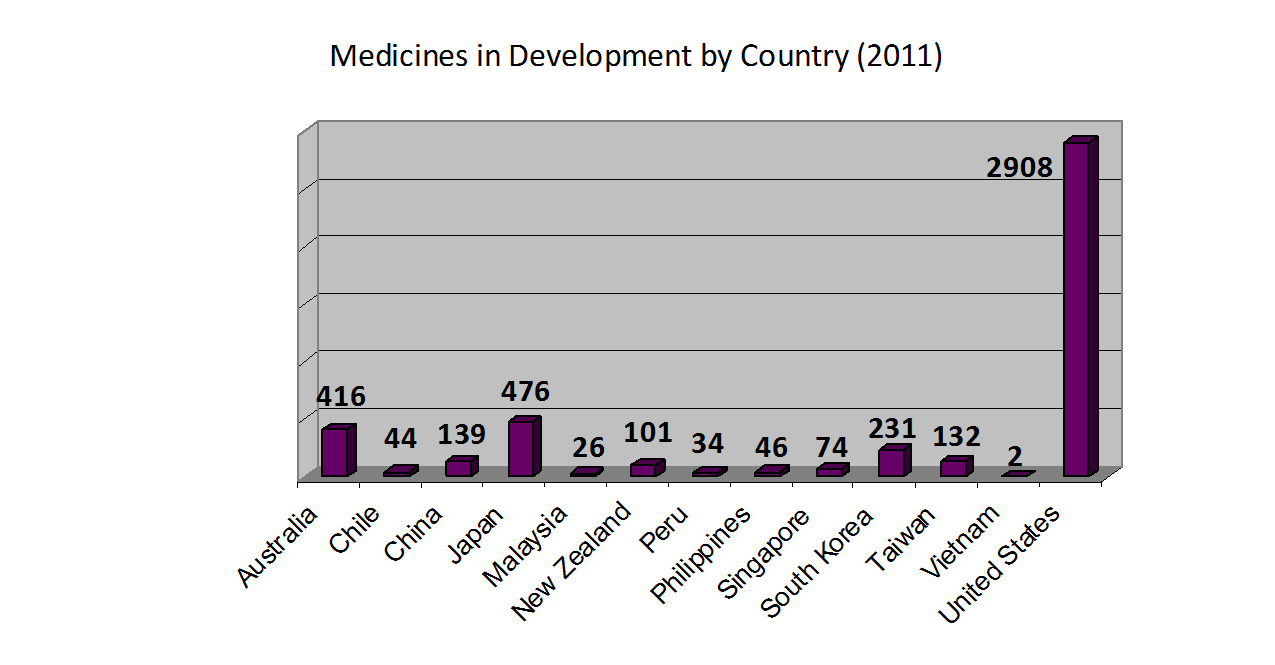
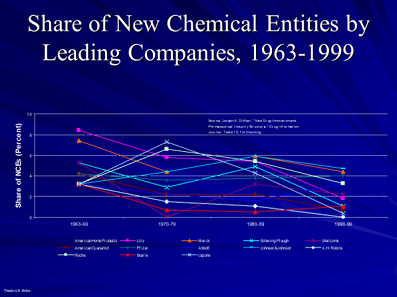
Complex, Risky and Expensive
References:
Felkey, A.J. and K.M. Lybecker (2017) “ Do Restrictions Beget Responsibility? The Case of U.S. Abortion Legislation” (2017) The American Economist, forthcoming.
Lybecker, K.M. (2016) “The Biologics Revolution”, chapter 1 in “Intellectual Property Rights and the Promotion of Biologics, Medical Devices and Trade in Pharmaceuticals”, Fraser Institute, Vancouver, BC, Canada.
Lybecker, K.M. (2016) “Illicit Trade in Counterfeit Medicines”, chapter 4, in OECD Reviews of Risk Management Policies: Illicit Trade Converging Criminal Networks, OECD Publishing, 79-122.
Lybecker, K.M. (2016) “Intellectual Property Protection for Biologics: Why the Trans-Pacific Partnership (TPP) Trade Agreement Fails to Deliver”, Journal of Commercial Biotechnology, 22(1): 42-48.
Johnson, D.N.J., K.M. Lybecker, D. Nadar and A. Schultheis (2016) “Should I Buy Here, or Keep Driving? The Effect of Geographic Market Density on Retail Gas prices” Journal of Business, 01(02): 12-20
Ravi Gunthey
Jai Narain Vyas University, India
Title: Role of Psychologist in Special and Inclusive Education
Time : 15:20-15:50

Biography:
Ravi Kant Gunthey, Head, Dept of Psychology, J.N.V.University, Jodhpur (India), has his expertise in the field of Special Education and Mental Health. He has 30 years of research experience, more than 50 papers published in Indian and International Journals, supervised 22 Ph.D. scholars.
Abstract:
Psychology has a pivotal role to play in the global world and holistic living. Application of Psychology is being witness in multiple areas and is a matter of grave concern that where we are needed most, there our place is being filled by scholars of other discipline. Have we ever paid attention to the thousands of PG. students who yearly come out of 5000 colleges of about 200 Universities? Are they being employed in the field of Psychology? The areas meant for psychologists are mentioned herein and are being encroached by other disciplines. One such area is the area of Special Education which teams with job opportunity and in replete with job satisfaction. The mandate given to RCI is to regulate and monitor services given to persons with disability and to standardize syllabi. Only one solution of all these issues is the role of Psychologist in this area- they have behavior assessment techniques, can counsel parents to bring their children to mainstream of society, can improve social interaction, awareness about misconceptions, initiating to establish special school in reference to inclusive education and application of Behavior modification techniques. UNICEF few years back suggests that there are at least 93 million children with disabilities in the world. Intellectual impairment is a term used when a person has certain limitations in mental functioning and in skills such as communicating, taking care of oneself and social skills. It is generally present in an individual who has an IQ test score of approximately 70 or below. Inclusive education is the new concept of education in which the disabled children are taught with the normal children in the regular classrooms. It also involves removing barriers in the environment, communication, curriculum, teaching, socialization and assessment at all levels.
Gary Young
Northeastern University, USA
Title: Effects of hospital - Physicians integration on quality of care: A study of cardiac services
Time : 16:10-16:40

Biography:
Gary Young is Director of the Northeastern University Center for Health Policy and Healthcare Research, as well as Professor of Strategic Management and Healthcare Systems, Northeastern University. His research generally covers management, legal, and policy issues affecting the delivery of healthcare services. Much of his recent research focuses on measuring and evaluating the performance of healthcare providers, particularly for quality of care, and the potential for using financial incentives to improve providers’ performance on quality metrics. Dr. Young has received research funding from both government agencies and private foundations, including the National Science Foundation, Agency for Healthcare Research and Quality, and the Robert Wood Johnson Foundation. He has published in such journals as the New England Journal of Medicine, Journal of the American Medical Association, Health Affairs, Medical Care, Journal of Health Economics, and Academy of Management Journal.
Abstract:
This study investigated whether integration of hospitals and physicians is associated with better care for patients with cardiac conditions. A dramatic change in the U.S. hospital industry is the integration of hospital and physicians through hospital acquisition of physician practices. Yet, little evidence exists regarding whether this form of integration leads to better quality of care. The study was conducted as an observational investigation and was based on a new theoretical model that integrated concepts from economics, organizational behaviour, and medical sociology. The study sample comprised over 300 hospitals in the State of California. The time frame for the study was 2010 to 2013. The key performance measures were hospitals’ degree of compliance with performance criteria set out by the federal government for managing patients with cardiac conditions. These criteria relate to the types of clinical tests and medications that cardiac patients should receive but hospital compliance requires the cooperation of physicians. Data for these measures were obtained from a federal web site that presents performance scores for U.S. hospitals. The key independent variable was the percentage of cardiologists that a hospital employs (versus cardiologists who are affiliated but not employed by the hospital). Data for this measure was obtained from the State of California which requires hospitals to report financial and operation data each year including numbers of employed physicians. Other characteristics of hospitals (e.g., information technology for cardiac care, volume of cardiac patients) were also evaluated as possible complements or substitutes for physician employment by hospitals. Additional sources of data included the American Hospital Association and the U.S. Census. Empirical models were estimated with generalized estimating equations (GEE). Findings suggest that physician employment is positively associated with better hospital performance for cardiac care. However, findings also suggest that information technology is a substitute for physician employment.
References:
Alexander, J.A. & Young, G.J. 2016. Health Professionals and Organizations – Moving toward True Symbiosis. In Hoff, T.J., Sutcliffe, K.M, & Young, G.J. (Eds.), The HealthCare Professional Workforce: Understanding Human Capital in a Changing Industry. New York, New York: Oxford University Press.
Baker, L.C., Bundorf, M. K., & Kessler, D.P., 2014. Vertical integration: Hospital ownership of physician practices is associated with higher prices and spending. Health Affairs, 33(5): 756-763.
Forbes, S.J. & Lederman, M., 2009. Adaptation and vertical integration in the airline industry. The American Economic Review, 99(5): 1831-1849.
Friedberg, M.W., Chen, P.G., White, C., Jung, O., Raaen, L., Hirschman, S., Hach, E., Stevens, C., Ginsburg, P.B., Casalino, L.P., Tutty, M., Vargo, C., Lipinski, L. 2015. Effects of Health Care Payment Models on Physician Practice in the United States. Santa Monica, CA: RAND Corporation.
Young, G. J., Nyaga, G. N., & Zepeda, D., 2016. Hospital employment of physicians and supply chain performance: An empirical investigation. Health Care Management Review, 41(3): 244-255.
Jaffe Eliezer
Haifa University, Israel
Title: Wisdom of the crowd in saving lives
Time : 16:40-17:10

Biography:
Eli Jaffe is the Director of Training, PR, Volunteer Activities, Marketing and International Relations Division, of the Israeli national EMS organization Magen David Adom. He has published books and articles and is an authority in the fields of emergency medicine and medical management, and is also one of the leading researchers in Israel in the field of volunteers and the prevention of PTSD. Dr. Jaffe is a well-known lecturer in the Israeli universities.
Abstract:
How can EMS (Emergency Medical Services) be anywhere at any time? In medical emergencies, time is crucial, the ideal situation is to have ambulances right next to the event. Due to limitations, this ideal situation cannot be reached. Recruiting available resources such as trained personnel in the society and social media that are available to save lives. The actions that can be taken to exploit the wisdom of the crowd in saving lives even before the ambulance arrives.
“Life Guardians”- Project. Harnessing resources available in the population who have medical training. Doctors, nurses, paramedics, and first aid providers who do not belong to MDA (Magen David Adom- Israel National EMS). The advantages are: Resources available in the community. Power multiplier, availability to react quickly and everywhere in collaboration even without belonging to the organization. Base of Volunteers & Standby Medics. All you need is medical training, an application, and basic equipment.
Social Media: Today, drivers use apps such as "Waze" when they drive. They report road accidents. The advantage is clear - a quick and precise location on long roads. Saving valuable time in locating an accident and thus causing quick care which will inevitably save lives.
Designated apps such as "MyMDA". In every emergency dispatch in the world, the dispatchers are blind. They can talk and hear, but they can’t see. This is the first time in the world that the dispatchers can see the scene before the ambulance arrives. MyMDA can relay users’ location, medical info and video from scene to dispatchers
Igbinoba Angie
Covenant University, Nigeria
Title: Gender Analysis of the Adoption of Information and Communication Technologies (ICTS) among rural farming dwellers in Oyo State, Nigeria
Time : 17:10-17:40

Biography:
Angie holds professional qualifications as a Registered Integrated Marketing Communicator of Nigeria with the Certified Marketing Communications Institute of Nigeria (CMCIN) and an Associate Member of the Advertising Practitioners’ Council of Nigeria (APCON). She served as a cub reporter and interviewer with the print media organization known as New Nigeria Newspaper (NNN) Ltd in 2004; she also worked with the broadcast media organization known as Africa Independent Television (AIT), in 2008, where she was involved in preparing, proofreading and editing news reports for on-air transmission. Angie possesses the gift of gab with good writing and editing skills. Some of the undergraduate courses taught include speech communication & rhetoric, broadcast station management & programming, foundation of broadcasting, announcing & presentation, et cetera. She is an up-and-coming whiz kid in the field of Health Communication whose on-going Ph.D. research focuses on the mass media and safe motherhood.
Abstract:
The high illiteracy level in most rural communities of the country is not representative of positive impacts information and communication technologies (ICTs) have had on Nigerian rural agriculture in terms of productivity, growth and development. The study investigated adoption of ICT among rural farming dwellers in Iseyin Local Government Area of Oyo state, Nigeria, based on gender analysis. A well-structured interview schedule was employed to elicit quantitative information from 60 male and 60 female rural farming dwellers from Serafu, Ado-awaye and Osoogun in Iseyin Local Government Areas, using the two stage random sampling procedure. Results showed that 55% of the male respondents and 46.7% of the female respondents adopted various selected ICT in general. Analysis of Variance (ANOVA) at <0.05 level of significance resulted that a significant difference exists in the adoption of the ICTs of both male and female respondents (F=4.198). The findings revealed that at <0.05 level of significance, significant difference existed in the level of income of the male and female respondents (F= 4.079). Therefore, in order to bridge the gender division in the level of adoption of ICTs, among rural dwellers, it was recommended that various ICTs should be made available for rural dwellers at subsidized rate because larger percentage of them know the importance and benefit of ICTs but lack the financial capacity to acquire them. The government should formulate policy that will enhance continuous utilization of ICTs for rural activities and for development of rural livelihood, in Nigeria.
References:
Gbenga, F.K and Deji, O. F. (2015) Gender analysis of technologies utilization among small scale oil palm fruits processors in Ondo state, Nigeria. Acta Agronomica. 64:1.
2. Olatade, K. O., Olugbire, O. O., Adepoju, A. O, Aremu, F. J. and Oyedele, P. B. (2016). How do farmers’ characteristics affect their willingness to adopt agricultural innovation? The case of bio-fortified Cassava in Oyo state, Nigeria. International Journal of Science and Technology. 5: 9-15.
3. Igbinoba, O. A. et al. (2016). New media and HIV/AIDS awareness among married women. Communication Review, 7:3, Nigeria: The Department of Mass Communication, University of Lagos. Pp 119-136.
4. Olugbire, O. O., Aremu, F. J., Opute, O. H., Ojedokun, C. A., Ayomide, A. A., and Oguntoye, T. O. (2016). Contribution of fuel wood marketing to sustainable livelihood in Oyo state, Nigeria. Russian Journal of Agriculture and Socio Economic Sciences. 3: 51-57.
5. Kassali, R., Aremu, F. J., and Shittu, B. A. (2015). An economic analysis of watermelon marketing in Oyo state, Nigeria. Journal of Production, Agriculture and Technology. 11: 43-52
6. Baruwa, O. I., Kassali, R., and Aremu, F. J. (2015). Adoption of improved maize varieties among farming households in Osun state, Nigeria. Journal of Production, Agriculture and Technology. 11:1-9
7. Ogunsola, G. O., Olugbire, O. O., Oyekale and Aremu, F. J. (2015). Understanding perception and adaptation to climate change among cocoa farmers in tropical Condition (2015). Ethiopian Journal of Environmental Studies and Management 8 (Suppl.1): 816-825. Doi:http://bx.doi.org/10.4314/ejesm.v8i1.9S
8. Olugbire, O. O., Aremu, F. J., Oyedele, P. B., and Ogedengbe, T. A. (2015). Analysis of profitability and operational efficiency of shea butter marketing: Empirical evidence from Ibadan, Oyo state, Nigeria. Journal of Sciences and Multidisciplinary Research 7: 40 – 46.
9. Olugbire, O. O., Adetunji, M. O., Aremu, F. J., and Iyiola, O. (2015) Poverty and Development among Rural Farmers: Implication on Nigeria’s Economy. A research article presented at the 3rd National Workshop cum Conference of Sustainable Livelihoods Development Network for Africa (SLIDEN) at Ladoke Akintola University of Technology, Ogbomosho, Nigeria.
10. Deji O. F. (2013). Gender analysis of fish farming technologies adoption by farmers in Ondo state. Scientific Research Essays 8 (26): 1219-1225
- Sociology | Nursing | Psychology | Education | Medicine | Behavioral Studies | Humanities
Location: Atlantis 1

Chair
Adenrele Awotona
University of Massachusetts Boston, USA

Co-Chair
Scott Dittloff
University of the Incarnate Word, USA
Session Introduction
Michelle Garcia Torres
Autonomous University of Mexico, Mexico
Title: Adult attachment as a predictor of the family functioning: A study with Mexican mothers
Time : 12:05-12:35

Biography:
Michelle Garcia-Torres has her expertise in the study of Mexican family (especially single-parents families), parent styles, interpersonal relationships and social support. Her passion is helping women through social programs promoted for the Autonomous University of Mexico and some ONG. She has designed a model to explain family functioning in Mexico considering psychology and ethno psychology aspects. She is part of a new generation of researchers in Mexico.
Abstract:
Statement of the problem: Attachment is an affectional bond presents in all human beings, a relatively durable union in which the partner is unique. There are four styles that describe the way people relate with their attachment figures: secure, preoccupied, avoidance and fearful. Attachment is a global style that directs the interpersonal relationships, especially with significant others and family members. Researchers have reported an effect of the parents´ attachment over familiar adaptability and cohesion. In addition, it has found that mothers with avoidance style of attachment could have a negative effect to the family system. It has reported that attachment´s styles have different impact depending on the culture. In the case of Mexico avoidance is related to lower relationship satisfaction and more conflict. Mexican family is the source of the most enduring relationships, provides material things and affection. Mexico as a collectivist culture promotes closeness and harmony relationships. The aim of this study was predict the family functioning through attachment´s styles in Mexican mothers.
Methodology & Theoretical Orientation: A quantitative, transversal study was conducted. The sample had 200 participants, with a mean age of 38.48 years (SD = 6.49). All of them responded two Liker-type scales; one evaluates the attachment and the other the family functioning in Mexican people. Five multiple lineal regression analyses were conducted to examine the data.
Findings: Preoccupied and secure were good predictors of positive familiar environment; Conflict inside the family was predicted by preoccupied and fearful; Amusement was predicted only by the secure attachment; Hostility was predicted by fearful and avoidance; and Coalitions were predicted by fearful and preoccupied attachment.
Conclusion & Significance: Attachment impacts the closest and more significant relationships with positive or negative outcomes. Recommendations are made to promote secure attachment to foster harmony and enjoyable relationships.
PAPIIT Project IN306616
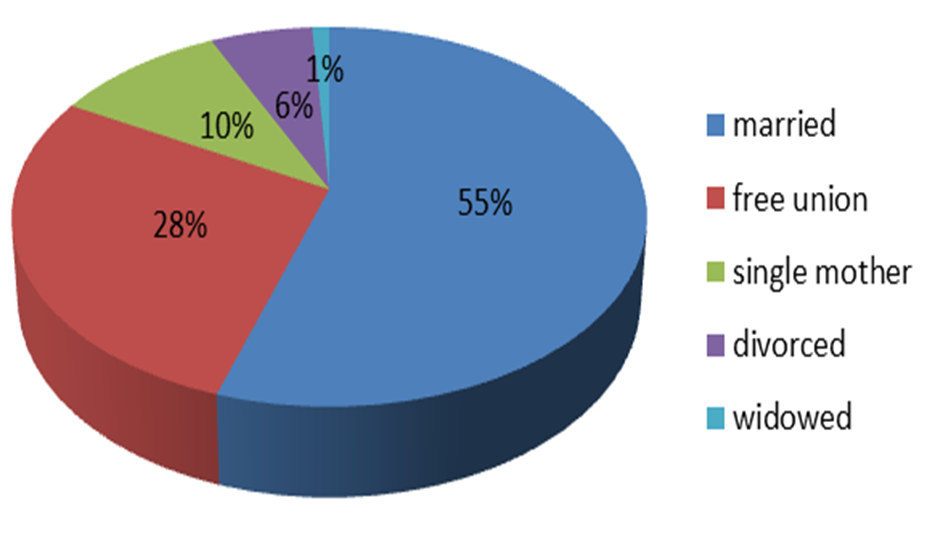
Participants
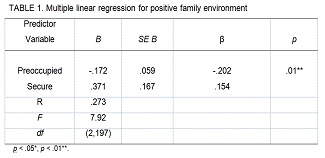
Multiple linear regressions for positive family environment
References:
Carreras, M. A., Brizzio, A., González, R., Mele, S., Casullo, M. M. (2008). Los estilos de apego en los vínculos románticos y no románticos. Estudio comparativo con adolescentes argentinos y españoles. Revista Iberoamericana de Diagnóstico y Evaluación - e Avaliação Psicológica, 107-124.
Friedman, M., Rholes, S., Simpson, J., Bond, M., Díaz-Loving, R., Chan, C. (2010). Attachment avoidance and the cultural fit hypothesis: A cross-cultural investigation. Personal Relationships, 17, 107-126.
García-Méndez, M., Rivera-Aragón, S., Díaz-Loving, R., & Reyes-Lagunes, I. (2015). Continuidad y cambio en la familia: factores intervinientes. México: Manual Moderno.
Pedro, M. F., Ribeiro, T., & Shelton, K. H. (2015). Romantic attachment and family functioning: The mediating role of marital satisfaction. Journal of Child & Family Studies, 24(11), 3482-3495. doi: 10.1007/s10826-015-0150-6.
Sheftall, A. H., Mathias, C. W., Furr, R. M., & Dougherty, D. M. (2013).Adolescent attachment security, family functioning, and suicide attempts. Attachment & Human Development, 15(4), 368-383. doi: 10.1080/14616734.2013.782649.
García-Torres, M., & García-Méndez, M. (en prensa), Escala de Apego Adulto no Romántico para población mexicana.
García-Méndez, M. (en prensa). Propiedades psicométricas de la Escala de Funcionamiento Familiar Modificada en una muestra mexicana.
Mirna Garcia Mendez
Autonomous University of Mexico, Mexico
Title: Adult attachment as a predictor of the family functioning: A study with Mexican mothers
Biography:
Mirna Garcia-Mendez is member of the National System of Researchers in Mexico. She has her expertise in the study of interpersonal relationships, culture and
family. She is the coordinator in the Academic Trajectory of Health and Behavioural Sciences area in the National Autonomous University of Mexico, where she is
in charge of projects which principal purpose is helping people in one of the poorest areas of Mexico.
Abstract:
Statement of the problem: Attachment is an affectional bond presents in all human beings, a relatively durable union in which the partner is unique. There are four styles that describe the way people relate with their attachment figures: secure, preoccupied, avoidance and fearful. Attachment is a global style that directs the interpersonal relationships, especially with significant others and family members. Researchers have reported an effect of the parents attachment over familiar adaptability and cohesion. In addition, it has found that mothers with avoidance style of attachment could have a negative effect to the family system. It has reported that attachment´s styles have different impact depending on the culture. In the case of Mexico avoidance is related to lower relationship satisfaction and more conflict. Mexican family is the source of the most enduring relationships, provides material things and affection. Mexico as a collectivist culture promotes closeness and harmony relationships. The aim of this study was predict the family functioning through attachment´s styles in Mexican mothers.
Methodology & Theoretical Orientation: A quantitative, transversal study was conducted. The sample had 200 participants, with a mean age of 38.48 years (SD = 6.49). All of them responded two Liker-type scales; one evaluates the attachment and the other the family functioning in Mexican people. Five multiple lineal regression analyses were conducted to examine the data.
Findings: Preoccupied and secure were good predictors of positive familiar environment; Conflict inside the family was predicted by preoccupied and fearful; Amusement was predicted only by the secure attachment; Hostility was predicted by fearful and avoidance; and Coalitions were predicted by fearful and preoccupied attachment.
Conclusion & Significance: Attachment impacts the closest and more significant relationships with positive or negative outcomes. Recommendations are made to promote secure attachment to foster harmony and enjoyable relationships.
PAPIIT Project IN306616
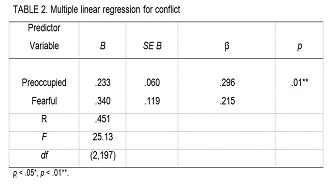
Multiple linear regression for conflict
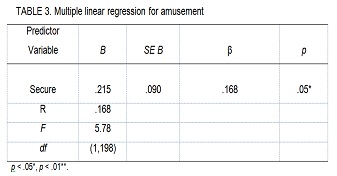
Multiple regression for amusement
References:
Carreras, M. A., Brizzio, A., González, R., Mele, S., Casullo, M. M. (2008). Los estilos de apego en los vínculos románticos y no románticos. Estudio comparativo con adolescentes argentinos y españoles. Revista Iberoamericana de Diagnóstico y Evaluación - e Avaliação Psicológica, 107-124.
Friedman, M., Rholes, S., Simpson, J., Bond, M., Díaz-Loving, R., Chan, C. (2010). Attachment avoidance and the cultural fit hypothesis: A cross-cultural investigation. Personal Relationships, 17, 107-126.
García-Méndez, M., Rivera-Aragón, S., Díaz-Loving, R., & Reyes-Lagunes, I. (2015). Continuidad y cambio en la familia: factores intervinientes. México: Manual Moderno.
Pedro, M. F., Ribeiro, T., & Shelton, K. H. (2015). Romantic attachment and family functioning: The mediating role of marital satisfaction. Journal of Child & Family Studies, 24(11), 3482-3495. doi: 10.1007/s10826-015-0150-6.
Sheftall, A. H., Mathias, C. W., Furr, R. M., & Dougherty, D. M. (2013).Adolescent attachment security, family functioning, and suicide attempts. Attachment & Human Development, 15(4), 368-383. doi: 10.1080/14616734.2013.782649.
García-Torres, M., & García-Méndez, M. (en prensa), Escala de Apego Adulto no Romántico para población mexicana.
García-Méndez, M. (en prensa). Propiedades psicométricas de la Escala de Funcionamiento Familiar Modificada en una muestra mexicana.
Yee Leung
The Chinese University of Hong Kong
Title: Monitoring and mitigation of physical and mental health problems in high density cities: An interdisciplinary approach

Biography:
Yee Leung is the Director of the Institute of Future Cities and Research Professor of the Department of Geography and Resource Management at The Chinese University of Hong Kong. He has done significant research in the probabilistic approach to uncertainty analysis in general and uncertainty propagation in geographical information systems in particular. He pioneers research in geographical analysis under fuzziness, and generalizes uncertainty analysis to various types of uncertainty using rough set theory, possibility theory, and theory of evidence. He also engages in novel research in climate dynamics, air quality analysis, spatial epidemiology, urban and regional analysis, intelligent spatial decision support systems, and spatial data mining and knowledge discovery.
Abstract:
Rapid urban growth in high density cities has generated tremendous environmental and mental stress that threatens the physical and mental well-beings of the city residents. It in turn impacts on our health and productivity, as well as the sustainability of a city. Therefore, effective monitoring and mitigation of our environmental conditions and related health issues is of utmost importance for us to lead a smart and healthy living in our fast changing city landscapes. This research shows how social scientists can work together with the engineering and medical scientists to develop a holistic approach to the monitoring and mitigation of physical and mental health problems in high density living. Specifically we will demonstrate how air pollution can be monitored and analysed through an air pollution decision support system that integrates multisource, multi-type and multi-scale data related to air pollution. We will show how public sentiments and opinions can be incorporated into the analysis framework to gauge the impact of air pollution on the society in general and people in particular. Furthermore, we will show how mobile devices and wearable’s can be deployed to monitor our physical and mental states, and how a personalized health care advisory system can be developed to alleviate physical and mental stress. We will employ real-life examples solved by the research team in the Institute of Future Cities at The Chinese University of Hong Kong to substantiate our arguments.
References:
Ming Luo, Yee Leung, Yu Zhou and Wei Zhang. “Scaling Behaviors of Global Sea Surface Temperature”. Journal of Climate 3122-3132., 2015.04.14.
Yee Leung, Nan-Nan Ji and Jiang-Hong Ma. “An Integrated Information Fusion Approach Based on the Theory of Evidence and Group Decision-making.” Information Fusion, 14 (2013): 410-422.
Shun Wai Tsang and Yee Leung. “A Theory-Based Cellular Automata for the Simulation of Land-Use Change”. Geographical Analysis, 43(2011), 142-171.
Leung Yee; Erjia Ge; and Yu, Zu-Guo. “Temporal Scaling Behavior of Avian Influenza A (H5N1): The Multifractal Detrended Fluctuation Analysis”. Annals of the Association of American Geographers, 101(2011): 1221 - 1240.
Yee Leung. Knowledge Discovery in Spatial Data. Berlin: Springer-Verlag, 2010, 360 pages.

Biography:
Angie holds professional qualifications as a Registered Integrated Marketing Communicator of Nigeria with the Certified Marketing Communications Institute of
Nigeria (CMCIN) and an Associate Member of the Advertising Practitioners’ Council of Nigeria (APCON). She served as a cub reporter and interviewer with the print media organization known as New Nigeria Newspaper (NNN) Ltd in 2004; she also worked with the broadcast media organization known as Africa Independent Television (AIT), in 2008, where she was involved in preparing, proofreading and editing news reports for on-air transmission. Angie possesses the gift of gab with good writing and editing skills. Some of the undergraduate courses taught include speech communication & rhetoric, broadcast station management &
programming, foundation of broadcasting, announcing & presentation, et cetera. She is an up-and-coming whiz kid in the field of Health Communication whose on-going Ph.D. research focuses on the mass media and safe motherhood.
Abstract:
This study examines how autism campaigns placed on the Nigerian broadcast media can create awareness and influence the perception people have of autism victims in Nigeria. The autism campaigns selected for the study were those carried out by the Patrick Speech Centre for Languages – an organisation for autism and people with learning disabilities – because the organisation has been in the fore front of autism awareness in the mass media. This study set out to discover: autism campaigns promoted in the Nigerian broadcast media; the different means of autism awareness; the influence of autism campaign on autism awareness and perception of autistic victims; and the level of exposure to autism campaigns. This study comprised a sample size of 81 survey participants; it was a combination of the simple random, purposive and cluster sampling techniques. The diffusion of innovations and perception theories were adopted in this study. Findings revealed that autism campaigns were actually promoted in the Nigerian broadcast media but have not, however, been successful in influencing autism awareness and the perception people have of autistic victims. They also showed a low level of exposure to autism campaigns among the survey participants. Part of the recommendations in this study was that autism campaign organisers should carry out thorough research on their target audience, message and communication medium before executing any campaign project while media professionals were urged to do more of autism awareness by setting agenda on autism and giving the issue prominence as this also helps to create awareness on autism.
References:
Gbenga, F.K and Deji, O. F. (2015) Gender analysis of technologies utilization among small scale oil palm fruits processors in Ondo state, Nigeria. Acta Agronomica. 64:1.
Olatade, K. O., Olugbire, O. O., Adepoju, A. O, Aremu, F. J. and Oyedele, P. B. (2016). How do farmers’ characteristics affect their willingness to adopt agricultural innovation? The case of bio-fortified Cassava in Oyo state, Nigeria. International Journal of Science and Technology. 5: 9-15.
Igbinoba, O. A. et al. (2016). New media and HIV/AIDS awareness among married women. Communication Review, 7:3, Nigeria: The Department of Mass Communication, University of Lagos. Pp 119-136.
Olugbire, O. O., Aremu, F. J., Opute, O. H., Ojedokun, C. A., Ayomide, A. A., and Oguntoye, T. O. (2016). Contribution of fuel wood marketing to sustainable livelihood in Oyo state, Nigeria. Russian Journal of Agriculture and Socio Economic Sciences. 3: 51-57.
Kassali, R., Aremu, F. J., and Shittu, B. A. (2015). An economic analysis of watermelon marketing in Oyo state, Nigeria. Journal of Production, Agriculture and Technology. 11: 43-52
Baruwa, O. I., Kassali, R., and Aremu, F. J. (2015). Adoption of improved maize varieties among farming households in Osun state, Nigeria. Journal of Production, Agriculture and Technology. 11:1-9
Ogunsola, G. O., Olugbire, O. O., Oyekale and Aremu, F. J. (2015). Understanding perception and adaptation to climate change among cocoa farmers in tropical Condition (2015). Ethiopian Journal of Environmental Studies and Management 8 (Suppl.1): 816-825. Doi:http://bx.doi.org/10.4314/ejesm.v8i1.9S
Olugbire, O. O., Aremu, F. J., Oyedele, P. B., and Ogedengbe, T. A. (2015). Analysis of profitability and operational efficiency of shea butter marketing: Empirical evidence from Ibadan, Oyo state, Nigeria. Journal of Sciences and Multidisciplinary Research 7: 40 – 46.
Olugbire, O. O., Adetunji, M. O., Aremu, F. J., and Iyiola, O. (2015) Poverty and Development among Rural Farmers: Implication on Nigeria’s Economy. A research article presented at the 3rd National Workshop cum Conference of Sustainable Livelihoods Development Network for Africa (SLIDEN) at Ladoke Akintola University of Technology, Ogbomosho, Nigeria.
Deji O. F. (2013). Gender analysis of fish farming technologies adoption by farmers in Ondo state. Scientific Research Essays 8 (26): 1219-1225
Biography:
Darcy Hostetter-Lewis received her Bachelor of Science in Nursing from California State University, Chico in 2001. She obtained employment as a newly graduated
nurse in the specialty of obstetrical care and she remained working in labor and delivery for 9 years. Later she was recruited by a national education center and has travelled extensively throughout the United States, providing education to health care providers as to the provision of evidence based care for women with gestational diabetes. In 2011 she was drafted to the position of Manager of Education and Training at the hospital where she was employed, and she remained at that position for two years, developing a wide range of evidence based education and training for all hospital employees. She began teaching in 2006, and in addition to maintaining her personal nursing practice she has taught continuously for California State University, Chico for the past 10 years. Darcy left her management position in 2013 and returned to the clinical setting in order to pursue her Doctor of Nursing Practice degree through the University of Hawaii at Manoa, She successfully completed her doctorate in 2015, following ground breaking on her doctorate project, the Kristina Chesterman Memorial Clinic (KCMC) in Ozu Abam, Nigeria.
Abstract:
On September 24, 2013, 21 year old nursing student Kristina Chesterman was killed by a drunk driver. Kristina had planned to begin her nursing career caring for those in Africa who lack access to medical care and treatment. In honor of her memory, and to carry out the work she was unable to complete, health care providers and nursing students came together with a clinic developer in Nigeria to build The Kristina Chesterman Memorial Clinic (KCMC). The proposed focus of the clinic was determined following a review of literature and through interviews with locals from Southeastern Nigeria. The research concurred with the anecdotal evidence and clearly demonstrated the need for diabetes care, as well as for obstetrical and pediaric medical services. Maternal-child death rates remain high in Nigeria due to inadequate training of care providers leading to ineffective problem recognition and treatment during pregnancy, labor, and the postpartum period. The high death rate in children under 5 indicates there is a need for vaccination programs and improved pediatric care. It was determined the care provided at the KCMC will focus on women, children and patients with diabetes with future goals of dental care, ophthalmology and surgical services. Ultimately, the goal of the KCMC project is threefold: to provide much needed health care for citizens of rural Nigeria, to provide student nurses with a global vision of nursing, and to provide individuals who knew
Kristina with a positive way to cope with the death of their friend and classmate.
Biography:
Zaelani has been working as a Lecture at Mataram Islamic Institute (IAIN) Mataram. He is DIRUT "PRESIDENT DIRECTUR" at PT. Anugerah Bumi Lestari.
Abstract:
Caused of the certainty of multicultural realizing, the pluralist attitudes become a necessary for consummate peacekeeping. Creating dialogue and harmony relations between human being with their differences, become our duty in any capacity for harmonious and peace life rebuild. Through of the literature study, based on using religious education study approach, this study should find any conception of peace as well as contained in the holy book of Abraham religions.For all of those become invitation for us to create the world peace. Starting from the classical texts studies, which brought the world spirit of peace and harmony in its diversity of race, tribe, nation, religion, flow and the economic level, this study attempt to map peace existing references that written in Abraham religion holy books. May this assay will contribute for world peace especially in peace education of religion.
Mansooreh Tajvidi
Islamic Azad University, Iran
Title: Critical thinking in nursing education: Concept analysis
Biography:
Mansooreh has done her Ph.D. in Nursing Kashan University of Medical Sciences. She is Head of Nursing and Midwifery Faculty and also a Member of the Islamic Association of Islamic Azad University Professors. She is Member of Research Council of Faculty of Nursing and Midwifery, Islamic Azad University, Karaj Branch.
Abstract:
Background and aims: The development of critical thinking among nursing graduates is so much important that education experts refer to it as the main goal of all the educational endeavors. Despite the experts and scholars’ consensus over the importance of critical thinking in nursing education, there is a great diversity of views on its nature and definition. Therefore, we conducted this study aiming at analyzing the concept of critical thinking in the Iranian nursing education context.
Methods: Hybrid concept analysis method was used in three phases. In the theoretical phase, data was retrieved from Elsevier, Wiley, CINAHL, Proquest, Ovid, and Springer as well as Iranian databases such as SID, Magiran, and Iranmedex. The literature search used the keywords ‘critical thinking’,‘nursing’, ‘education’, and ‘nursing education’. The final sample included 35 papers published in English between 1990 and 2013. In the field work phase, a purposive sample of seventeen key informants was recruited- including seven nursing faculties, three PhD students, two clinical instructors, and five clinical nurses. Deep interviews was carried out with them. In the analytical phase the obtained data from theoretical and fieldwork phases was compared.
Results: Antecedents, attributes, and consequences of the critical thinking concept generated in the first and the second phases was compared and determined the similarities and differences. Finally commonalities of the two phases were identified. Finally definition of critical thinking in nursing education derived in literature and finding of this study was introduced.
Conclusion: Finding showed that critical thinking should be defined contextually; participants pointed out to several contextual factors—such as being interested in the persian literature and poems, relating the educational materials to the religious beliefs and asking the students to think about creation and existence—which had not been addressed in the literature.
